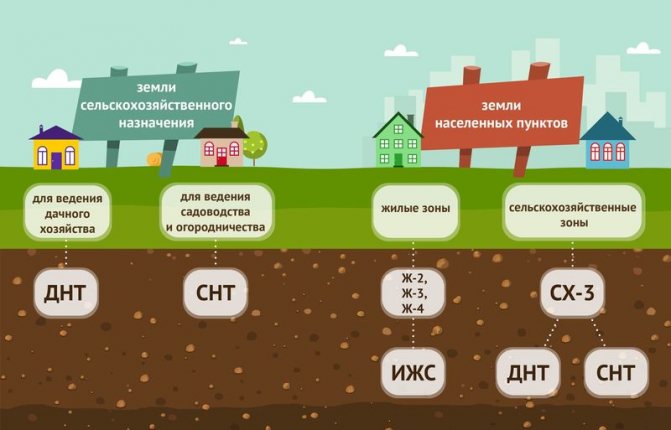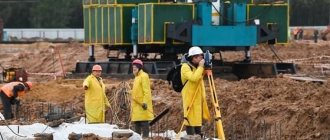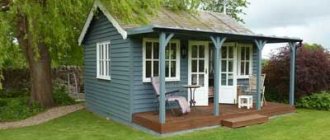SNT or individual housing construction - which is better? In 2021, this issue remains relevant, as citizens continue to actively acquire land plots for various purposes.
Legal use of them is possible only in case of official registration of ownership.
This is done taking into account the classification that determines what activities can be carried out on the site.
In the Russian Federation, there are 7 categories of land, but more often SNT and individual housing construction appear in purchase and sale transactions.
What is the difference between them and which storage area to choose in a given situation will be described in detail in the article.
Terminology: essence and main points
In order to understand how individual housing construction differs from SNT, it is necessary to understand the terminology before purchasing land.
The abbreviation SNT means garden non-profit partnership . On such plots the owner has every right to:
- grow crops;
- raise livestock;
- erect non-residential buildings;
- build a residential building.
Agricultural plots can be located both outside the city and within the populated area.
Decoding individual housing construction is also simple - individual housing construction . Such land plots are purchased for the construction of a private house with subsequent registration in it. Construction is carried out at the expense of the owner of the site and on the basis of permits.
Most often, individual housing construction is located within the city, as it must have a certain infrastructure and the ability to provide communications. Some land for construction is sold immediately with electricity, gas and water connected to the boundaries of the plot.
Due to the fact that it is allowed to build houses on plots of both categories, buyers often cannot decide which land plot to purchase, all other things being equal. It will be easier to do this by studying the pros and cons of individual housing construction and SNT.
What's the difference and which is better?
The main difference between the categories under consideration is this aspect: the territories of individual housing construction are settlement lands. The state invests money in their development. And SNT participants pay for everything at their own expense.

There are other differences:
- On plots for individual housing construction, you can obtain registration without any restrictions. In SNT, for this it is necessary to go through a lengthy procedure, which involves recognizing the building as residential and suitable for living.
- The territories of gardening non-profit partnerships are acquired for gardening and farming with the possibility of building country houses on them.
- Individual housing construction lands are considered promising, since the local budget allocates financial resources for their development. SNT develops only at the expense of the members of the partnership.
IMPORTANT! When choosing a territory, you should take into account many nuances and know various legal subtleties. It is necessary to clearly outline the purpose for which the site is intended.
To answer the question: “which is better: individual housing construction or SNT”, it is necessary to highlight a number of fundamental points:
- The advantage of individual housing construction is that local governments are developing the infrastructure of settlements. And the lands of non-profit gardening partnerships are developed only at the expense of its members.
- On the site for individual housing construction, it is possible to build residential buildings and cottages. The main thing is that the buildings meet the requirements established by law.
- The construction of any buildings is also allowed on SNT lands. But registration will become problematic, since the building must meet the requirements for permanent residence and have normal infrastructure.
- The cost of land for individual housing construction is more expensive than SNT. If you need a house for a summer weekend getaway, it is better to choose a gardening partnership.
- When it comes to building a house that will be intended for permanent residence, it is advisable to buy a plot of land using individual housing construction.
It is difficult to come to a consensus, so everyone must choose a category of land that corresponds to their goals.
To finally understand what is better, whether it is worth transferring SNT to individual housing construction, it is worth noting the disadvantages of building a house in horticultural areas:
- Buildings erected on lands allocated for horticulture or agriculture are not intended for permanent residence. They are considered summer houses.
- Registration is extremely difficult, and in some cases completely impossible.
- Difficulty living in winter in terms of travel.
- Difficulties with gasification, since this issue is not within the competence of the municipality.
Plots of individual housing construction land are in great demand and are considered the most prestigious. It will be easier to obtain a tax deduction for a house built on such a territory.
Advantages and disadvantages of SNT
Buying land from a gardening partnership has a lot of positive aspects . This list includes:
- low cost of allotment;
- location in a beautiful area away from city dust, noise and dirt;
- insignificant tax burden;
- simplified house registration system.
Just a few years ago, it was almost impossible to legally put a country house into operation, but due to the current country house amnesty, the situation has changed radically and the building is registered in a simplified manner with a minimum package of papers.
Agricultural land also has disadvantages:
- the need to join a gardeners' association;
- infrastructure development at the expense of land owners;
- concluding agreements on conducting communications through a partnership;
- inability to pledge a deposit in a bank.
Having decided to purchase SNT, you need to understand that most of the important issues will have to be discussed with the members of the partnership.
In addition, in the first years after registration of ownership, the owner will have to deal with infrastructure issues and only then begin building a house (if this is in the plans).
Advantages and disadvantages of individual housing construction
Real estate agents always start with the advantages of individual housing construction, because it really has a lot of them:
- developed infrastructure;
- presence of a legal address at the ZU;
- development of surrounding areas at the expense of municipal authorities;
- the opportunity to register with the whole family;
- no problems with communications;
- considering land as collateral;
- preferential tariffs for gas, electricity and water.
Against the backdrop of the advantages, the disadvantages seem insignificant to many potential land buyers, but they cannot be ignored:
- high cost of the site;
- expansion of borders only through the acquisition of another plot;
- the need to obtain all construction permits and design documentation;
- coordination of the project with the local administration;
- high taxes.
Before purchasing a plot of individual housing construction, you need to clearly determine the time frame for the construction of the future house - if the owner does not begin work within 5 years, the land plot will be forcibly purchased.
Main differences
What is better – SNT or individual housing construction – is difficult to determine at first glance. Therefore, it is worth highlighting the main differences between these categories of land.
They are:
- intended purpose;
- location.
Based on the intended purpose of the plots, the entire system for using them is built . Since individual housing construction is initially intended for development, it is possible to build not only cottages, but also townhouses, duplexes, and other types of residential real estate.
The most important thing is that the buildings are not higher than 3 floors, and the developer has all the necessary permits to carry out work.
But on SNT only the construction of a private house and outbuildings is allowed . A residential building must meet certain parameters:
- be no higher than 3 floors;
- have one owner.
The area of the house is not limited by any rules - the owner of the land plot has every right to erect a small country house with an area of 25 square meters and build a cottage of 250 square meters.
The main thing is that the building does not fall into the category of an apartment building. Otherwise, it is subject to demolition.
The location of plots also determines a lot in the lives of their owners . Individual housing construction is located within the city, and therefore future homeowners will have schools, shops, kindergartens and entertainment centers within walking distance.
In addition, the development of the land plot and adjacent territories is included in federal programs, which means it will be well financed. Although it must be taken into account that within the framework of such programs, the turn to certain settlements may reach in 5-10 years.
SNT refers to lands that have agricultural purposes, and therefore all issues regarding the development and improvement of territories fall on the shoulders of the land owners themselves. This is not a bad thing in all situations.
If the partnership consists of active people with high incomes, then through joint efforts in a couple of years the lands will be perfectly landscaped, and communications will be connected to each land plot.
Differences in land according to purpose
The Land Code of the Russian Federation divides all lands according to their intended purpose into seven types:
- for populated areas;
- agricultural;
- protected areas;
- for industrial facilities and industry;
- water fund;
- lands in reserve;
- forest fund.
In addition to the intended purpose assigned to them, the lands have an officially established type of permitted use for a specific site.
There are more than three thousand types of permitted use of land in Russia. Each such type determines what activities are permitted on that land.
- garden residential buildings;
- for agricultural production;
- for gardening;
- for running a farm (peasant) economy.
- blocked residential buildings;
- for the construction of dachas;
- for individual housing construction.
When purchasing a plot of land, you need to take into account all your requests, determine what it is needed for, whether there will be buildings on it, and what status is required of them. Based on this, its permitted type of use should be selected.
The purpose of a piece of land may be as follows:
- dacha non-profit partnership, abbreviated as DNP;
- gardening non-profit partnership, abbreviated as SNT;
- personal subsidiary plot, abbreviated as personal subsidiary plot;
- individual housing construction, abbreviated as individual housing construction.
Lands of dacha and garden non-profit partnerships can only be located on agricultural lands, however, the placement of DNP plots, according to recent changes in legislation, has become possible on lands inside the settlement. Plots for individual housing construction must certainly be within the boundaries of residential settlements.
Each type of permitted use has its own advantages and disadvantages.
Analysis of differences
The quickest way to figure out which is better - individual housing construction or SNT - is to use a comparative analysis of the differences, presented in the form of tabular data.
| Characteristic | Land category | |
| individual housing construction | SNT | |
| Electrical networks | The line belongs to the nearest village, so after paying for connection to it, problems with capacity will not arise | The connection is made if there is a line with sufficient power, but even then the power is divided among all members of the partnership and it may not be enough to provide the cottage |
| Water supply | Central water supply | General or individual wells |
| Gas supply | Supply is feasible in most cases, and a number of settlements are provided with gas at a reduced rate | If there is a gas pipeline, connection is carried out at the expense of the owner of the land plot |
| Sewerage | Connection to the central system | Installation of an individual septic tank |
| Solving registration issues | Registration is carried out without delay if all permits are available | The dacha amnesty allows you to register in the shortest possible time and without tedious collection of papers |
| Current expenses | Tax, utility bills | Tax, shares, expenses for current repairs of public facilities |
Even such a detailed analysis will not give a complete picture of what choice to make when buying land . Theoretically, the buyer can draw one conclusion, but in practice the situation will be different.
There are cases when a purchased plot for housing construction required bringing all communications to the borders and introducing them into the territory.
Taking into account the receipt of permits, this process took more than six months and cost the owner several hundred thousand rubles in unplanned expenses.
And, on the contrary, the land of the gardening partnership, located 20 kilometers from the city, already had an installed electric cable and a septic tank. As a result, the preparatory stage of construction did not take even 2 months. They went to drill the well and its equipment.
Based on everything said above, one conclusion can be drawn - each transaction for the purchase and sale of land should be considered individually, taking into account the pros, cons and the amount of additional expenses that the owner will have to bear in the first months.
comparison table
In order to better understand what exactly is better in this or that case, which property to choose and finally decide whether it is worth transferring land from one category to another, it is necessary to carefully compare the main aspects of the difference.
| What is the difference | individual housing construction | DNP, SNT |
| Electricity supply | It is located within the boundaries of energy supply, sufficient power and volume, since it belongs to a populated area. | You can connect if there is a power line nearby. Connection occurs at the expense of the interested party, with possible restrictions on power consumption. |
| Gas supply | Often technical capabilities allow. In this case, the land owner is assigned partial costs and some benefits. | Connection is only possible if the gas pipeline is close. In this case, the costs are borne by the participants of SNT and DNP. |
| Water supply | There is almost always a connection to the central water supply. Or the supply occurs through individual wells, taking into account preferential payment. | Often there is one well for everyone, financed by the share contributions of the participants. |
| Sewage system | There is a high probability of connecting to a central system or installing an individual drain with fixed tariffs. | A single system in the form of a local cleaning septic tank with the same joint costs. |
Transferring memory from one group to another
Most buyers are concerned about whether the purchased plot can be transferred to another category . The legislation allows such a procedure and is regulated by Federal Law No. 172. But you must immediately take into account that it is quite difficult to officially change the purpose of the memory.
Most often, land owners are interested in how to transfer SNT to individual housing construction . This is done only if the allotment meets a number of conditions:
- proximity to residential urban areas and utility networks;
- developed infrastructure that allows the homeowner to live comfortably on his territory;
- other factors determined by the commission on an individual basis.
The translation process itself consists of preparing an impressive package of papers. It includes:
- application (you can get it from the municipality);
- consent of all owners of the land plot, certified by a notary office (this point is relevant if the land has several owners);
- cadastral documents;
- technical papers;
- confirmation of ownership of the site;
- fresh extract from the Unified State Register of Individual Entrepreneurs.
After submitting the papers to the administration, the application will be considered within 30 calendar days . After their expiration, the response is sent in writing. A large percentage of decisions are negative, but the letter does not always reflect the reasons that prompted the authorities to act in this way.
It is advisable to try to transfer SNT into individual housing construction if the owner has already developed the site, erected a house, landscaped the territory and lives here all year round. Otherwise, the owner should not deal with translation issues.
Citizens are much less interested in how to transfer individual housing construction to SNT than in the previous topic. And there is a simple explanation for this - land for individual construction cannot be removed from its group and introduced into a gardening partnership.
Purchasing a plot for further residence: what to choose
To summarize, it is necessary to determine which plot is best to buy for permanent residence. In fact, you need to get your bearings on the spot after a thorough inspection of the property and a conversation with your future neighbors.
Individual housing construction is more suitable for construction and permanent residence . And there are several good reasons for such a decision:
- the lands are easy to develop, since they can initially be connected to all utility networks;
- they are located within the city, which means there will be no problems with the delivery of building materials and commuting;
- registration will not cause much trouble;
- good infrastructure will allow you to enjoy a comfortable life without leaving home.
But the big disadvantage of individual housing construction is its impressive cost, which many cannot afford.
If you still want to live in a beautiful place and have your own home, but your budget is limited, then you can take a closer look at SNT. Nowadays, quite a few gardening partnerships are located almost within walking distance from the city, which gives the plots many advantages:
- connection with the city by bus routes;
- cleaning roads in winter;
- developed infrastructure;
- powerful electrical lines;
- no restrictions on building a house.
The last point is due to the fact that the site does not have underground communications, which means a residential building can be erected anywhere at your discretion.
After the territory has been developed, the site can be removed from the SNT, but many owners do not do this, since the partnership gives them a lot of advantages.
If the buyer of land plans to vacation outside the city only in the warm season, then he should definitely opt for agricultural land.
Give a clear answer to the question “Which is better – SNT or individual housing construction?” difficult . Choosing the right site depends on many factors. First of all, the buyer should focus on the characteristics of the storage unit, his goals and financial capabilities.
If you take into account all the nuances, then life outside the city will bring only positive emotions, regardless of the category of the site on which the house stands.
Classification of land plots
What is individual housing construction? This is individual housing construction - this is a form of use and ownership of land plots that involves the construction of real estate on them at the expense of citizens’ personal funds.
Plots are provided only to individuals on the basis of ownership or long-term lease.
It is allowed to build capital construction projects with a height of no more than 3 floors on such sites.
Land can be allocated both within the city and in the territories of garden and dacha partnerships and cooperatives. But the legal regulation of land categories is different.
SNT - a gardening non-profit partnership - is an association of individuals with the goal of achieving various gardening and dacha issues.
The difference between SNT and plots for individual housing construction is in the categories of land that are provided to citizens for these purposes.
SNT, as a rule, are located on agricultural lands, and individual housing construction plots are located on the lands of urban settlements.
Purpose
In order to understand what is the difference between individual housing construction and SNT, it is necessary to compare the legal status of individual housing construction and SNT? All lands have a specific purpose.
The lands of urban settlements have the following purposes:
- Construction of residential facilities.
- Providing communications to the population.
- Transport purpose.
- Location of farmland.
- Other.
The lands of urban settlements are intended for:
| For individual housing construction | that is, for the construction of a property intended for year-round use |
| For personal farming | breeding livestock, growing crops, etc. |
| For country house construction | construction of a country house and other buildings that cannot be lived in all year round |
Construction on such sites is permitted only with a special document - a building permit, and all buildings must comply with the urban planning plan of the site.
Lands with agricultural purposes are intended for:
| Leading | agricultural production and personal subsidiary plots |
| Farming | or peasant farm |
| Vegetable gardening, horticulture, livestock farming | and country house construction |
It is possible to build on SNT lands, but only those buildings that are not intended for year-round living, do not have central communications and do not meet the requirements for residential premises.
Purpose of acquisition
A plot for individual construction is purchased, as a rule, for permanent residence or for the construction of a capital construction project.
Video: choosing a plot of land
The secondary cause is farming, horticulture, animal husbandry and horticulture.
As a rule, a plot of land in SNT is purchased in order to have somewhere to go on vacation in the summer, to plant beds and grow crops.
House construction is a secondary reason.









